The NVIDIA GeForce GTX 980 Review: Maxwell Mark 2
by Ryan Smith on September 18, 2014 10:30 PM ESTCompany of Heroes 2
Our second benchmark in our benchmark suite is Relic Games’ Company of Heroes 2, the developer’s World War II Eastern Front themed RTS. For Company of Heroes 2 Relic was kind enough to put together a very strenuous built-in benchmark that was captured from one of the most demanding, snow-bound maps in the game, giving us a great look at CoH2’s performance at its worst. Consequently if a card can do well here then it should have no trouble throughout the rest of the game.
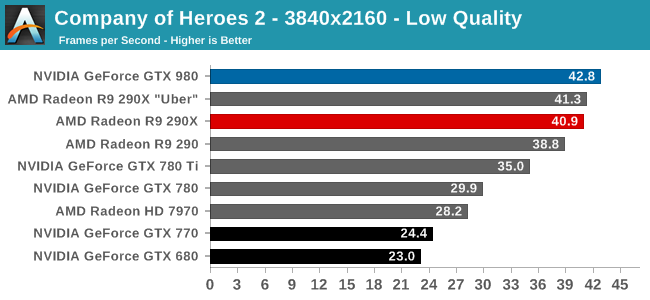

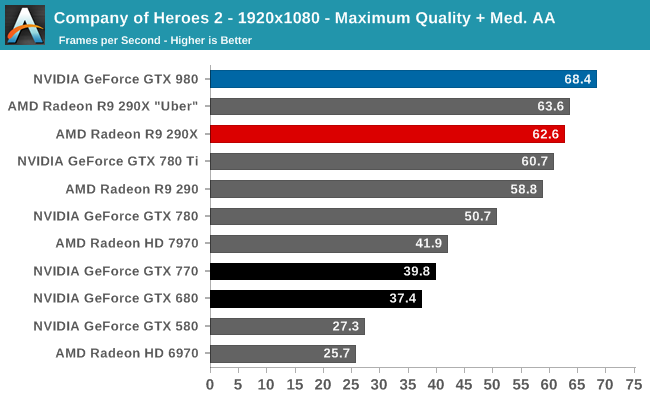
Since CoH2 is not AFR compatible, the best performance you’re going to get out of it is whatever you can get out of a single GPU. In which case the GTX 980 is the fastest card out there for this game. AMD’s R9 290XU does hold up well though; the GTX 980 may have a lead, but AMD is never more than a few percent behind at 4K and 1440p. The lead over the GTX 780 Ti is much more substantial on the other hand at 13% to 22%. So NVIDIA has finally taken this game back from AMD, as it were.
Elsewhere against the GTX 680 this is another very good performance for the GTX 980, with a performance advantage over 80%.
On an absolute basis, at these settings you’re looking at an average framerate in the 40s, which for an RTS will be a solid performance.
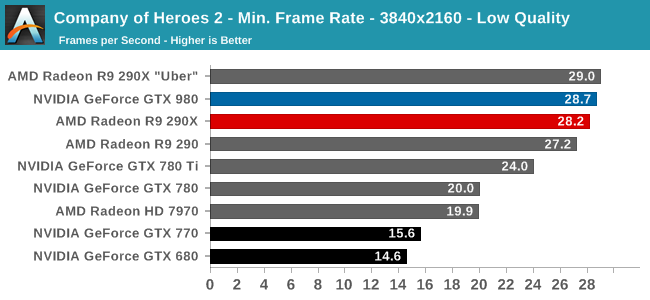
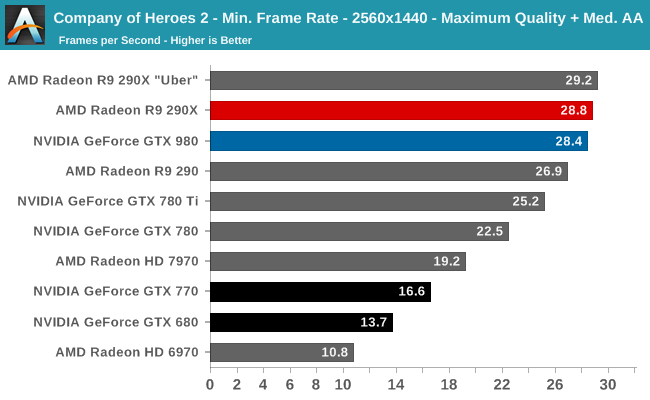
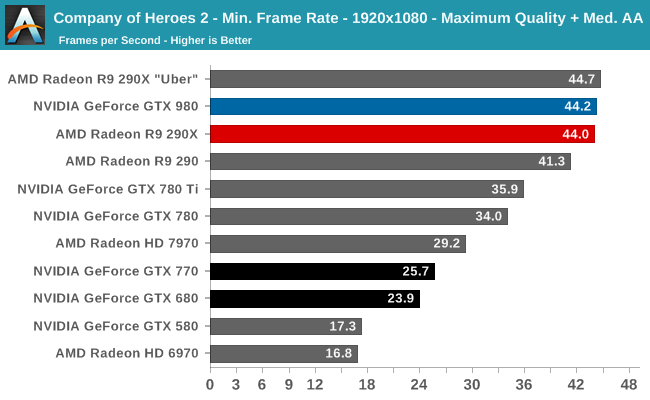
However when it comes to minimum framerates, GTX 980 can’t quite stay on top. In every case it is ever so slightly edged out by the R9 290XU by a fraction of a frame per second. AMD seems to weather the hardest drops in framerates just a bit better than NVIDIA does. Though neither card can quite hold the line at 30fps at 1440p and 4K.










274 Comments
View All Comments
rennya - Friday, September 19, 2014 - link
Any info what HDMI 2.0 level and HDCP version this nVidia GPU has? It can only be between these ywo; HDMI 2.0 level B HDCP 2.2 or HDMI 2.0 level A HDCP 2.0.If it was the former, gaming performance in 4K displays that use HDMI 2.0. If it was the latter, this card is DOA when Bluray 4K videos comes out.
khanov - Friday, September 19, 2014 - link
Ideally, we consumers want a full HDMI 2.0 spec transceiver with 20+Gbps bandwidth AND HDCP 2.2. But these are not yet available and that is why we see these stop-gap measures that manufacturers are calling HDMI 2.0 A and B. This should *hopefully* be resolved by next year.In the meantime, I'd also like to know what exactly Nvidia is offering in the 970 and 980 cards. Without HDCP 2.2 the compatibility of these cards with future TV and AV gear is questionable.
Ryan, are you able to clarify please?
Ryan Smith - Saturday, September 20, 2014 - link
I don't have any more information available. But I will look into it.AnnonymousCoward - Friday, September 26, 2014 - link
If the stupid TV industry had went with the existing and mature DisplayPort interface for 4K, we wouldn't have these stupid HDMI 2.0 problems.warisz00r - Thursday, September 18, 2014 - link
So is it viable to drop a 970 or 980 in a sub-600W setup?dishayu - Thursday, September 18, 2014 - link
The whole system peaks at 300W. Even a cheap, non 80+ certified 500W power supply should be able to deliver that much with complete safety.Alexvrb - Saturday, September 20, 2014 - link
I would NEVER buy a PSU that isn't at least a somewhat halfway decent 80+ certified unit. Especially if you're going to then combine it with expensive components. At this point anything that falls under the category of "Cheap non 80+" is as likely to explode and catch fire as it is to run with complete safety. :P$30 gets you a 500W 80+ certified unit anyway.
nandnandnand - Thursday, September 18, 2014 - link
"GM204 ends up weighing in at 5.2 billion transistors, with a die size of 398mm2. This compares to 3.54B transistors and a die size of 294mm2 for GK104, and 7.1B transistors for 551mm2 for GK110."Does this mean there will be a 10 billion transistor GM210
extide - Friday, September 19, 2014 - link
Probably, yes, but not @ 28nm ;)Laststop311 - Friday, September 19, 2014 - link
I think you are right. Unless there is another huge delay big maxwell will not see the light of day till 20nm. At 28nm the die size would be astronomical and thats too expensive.